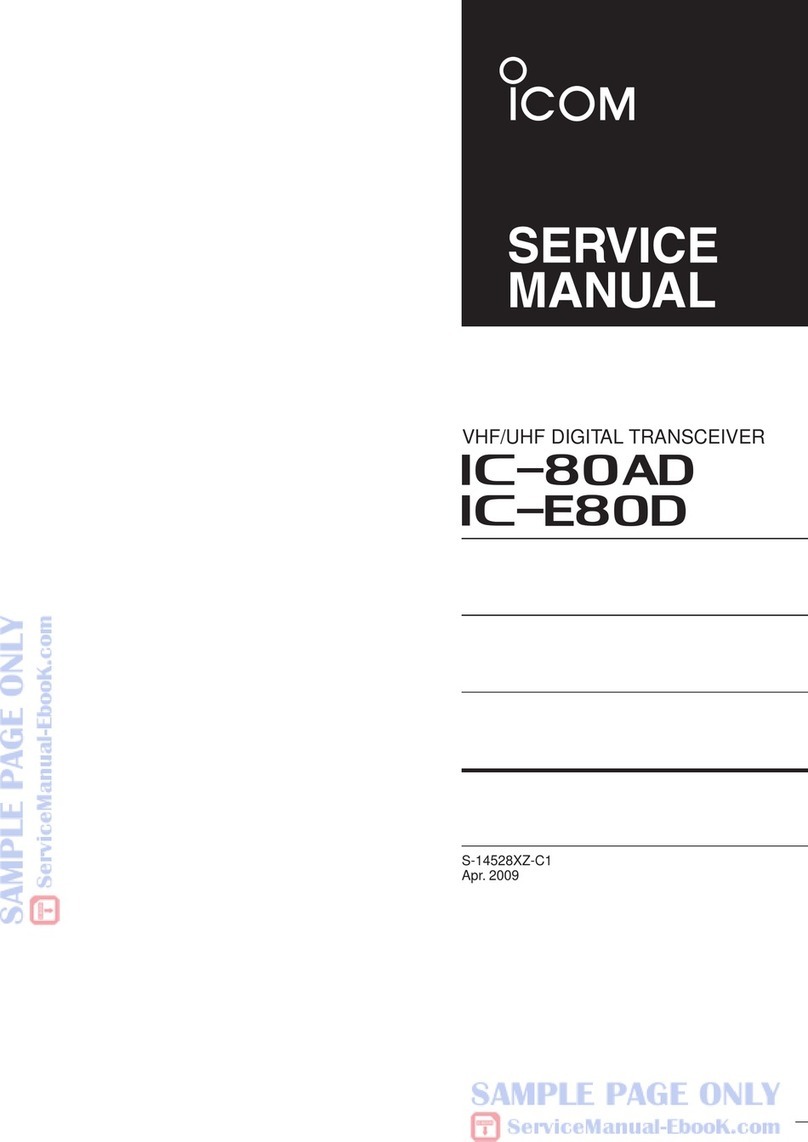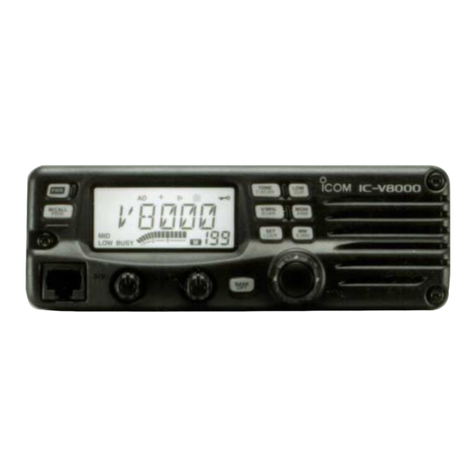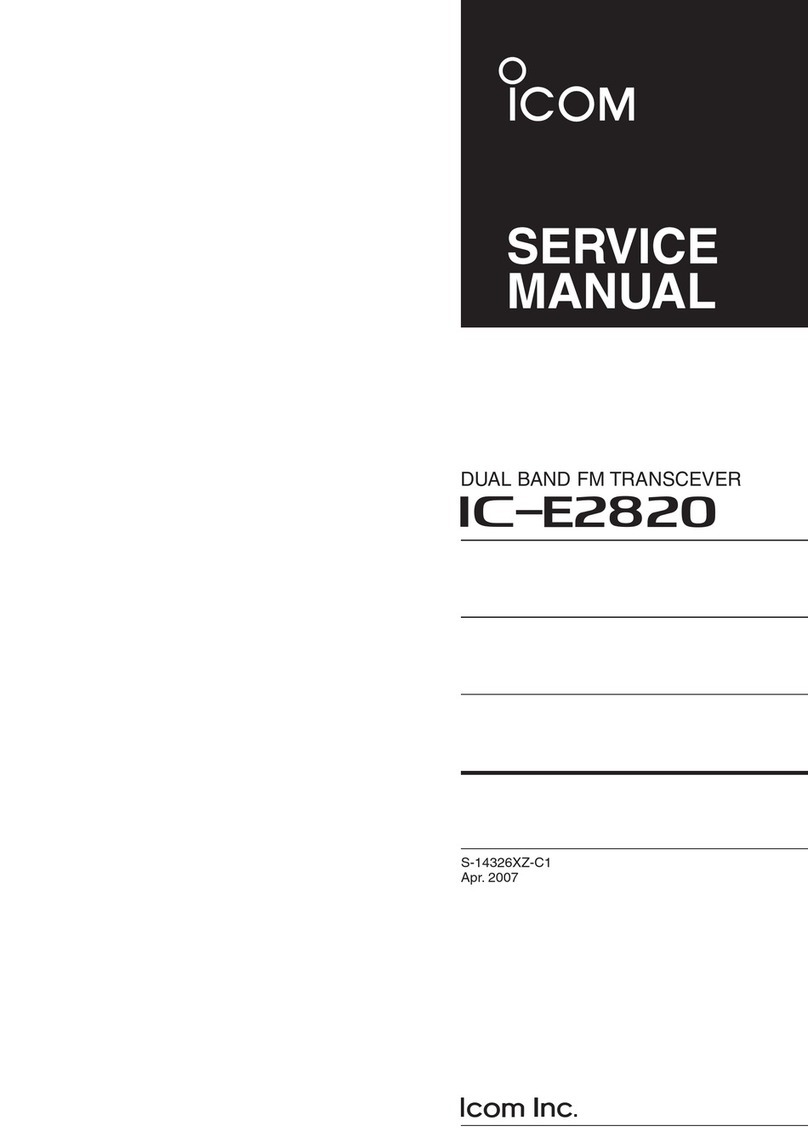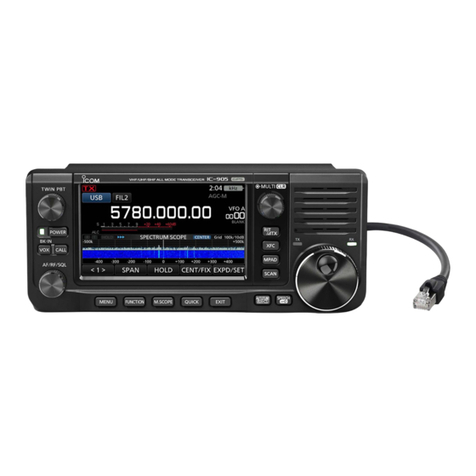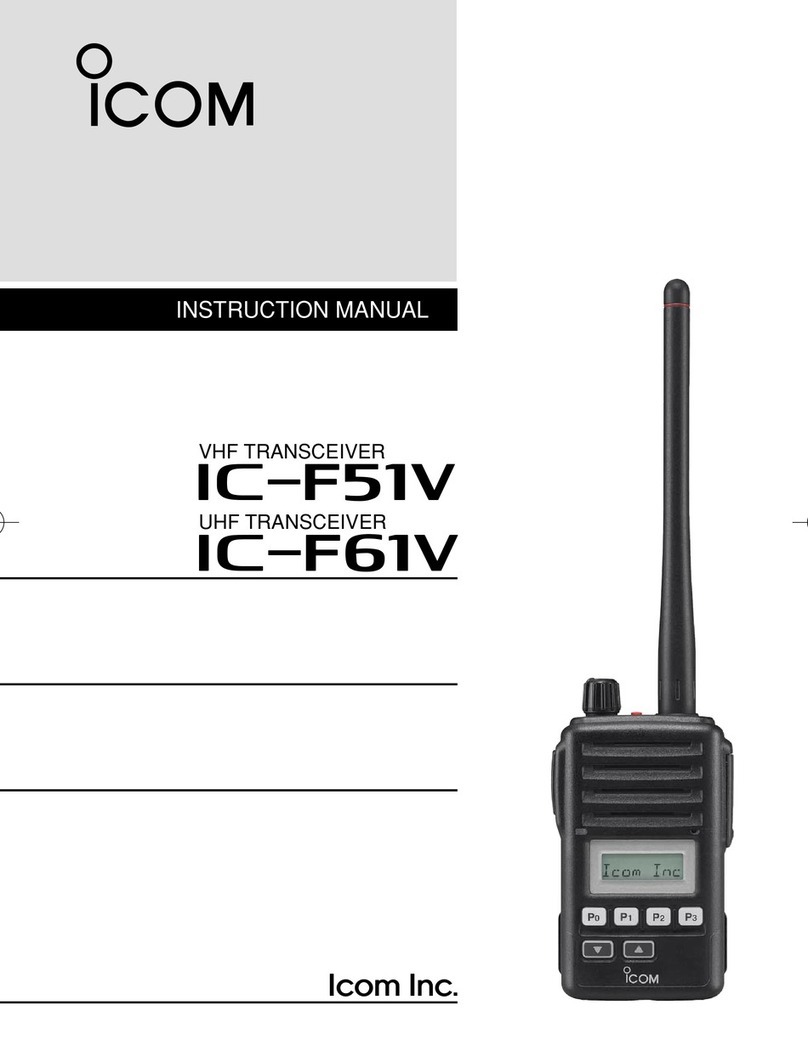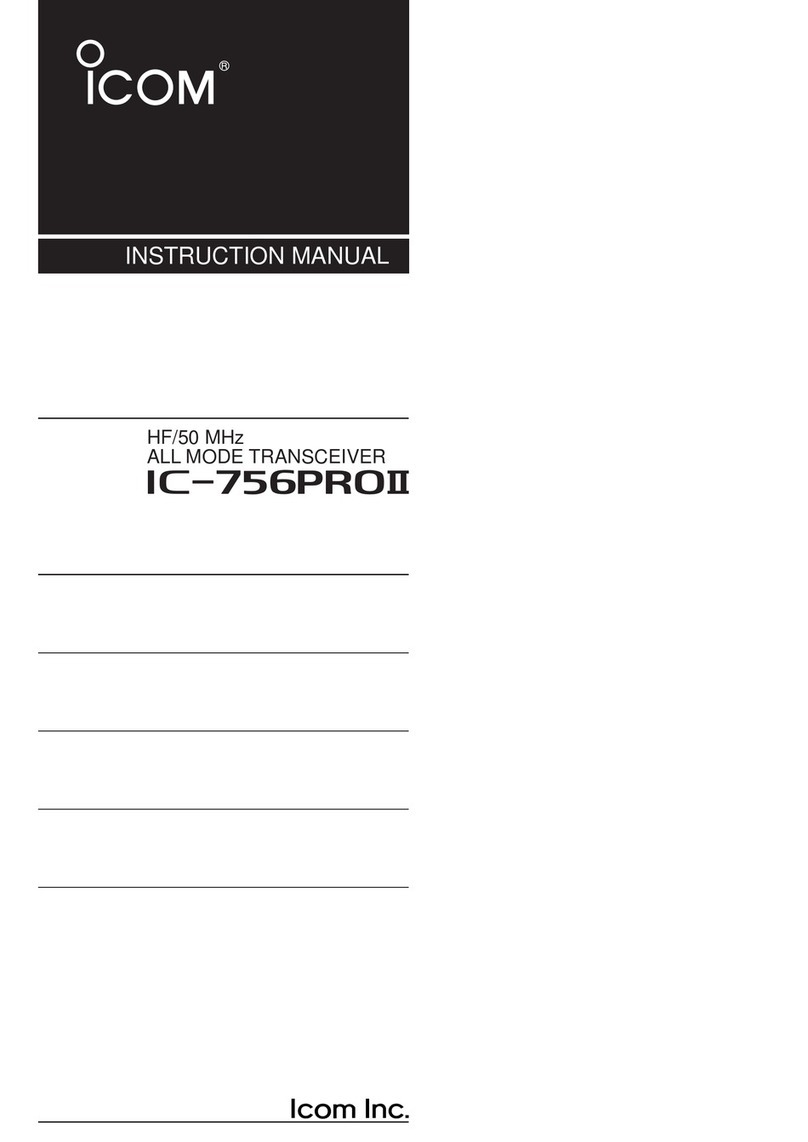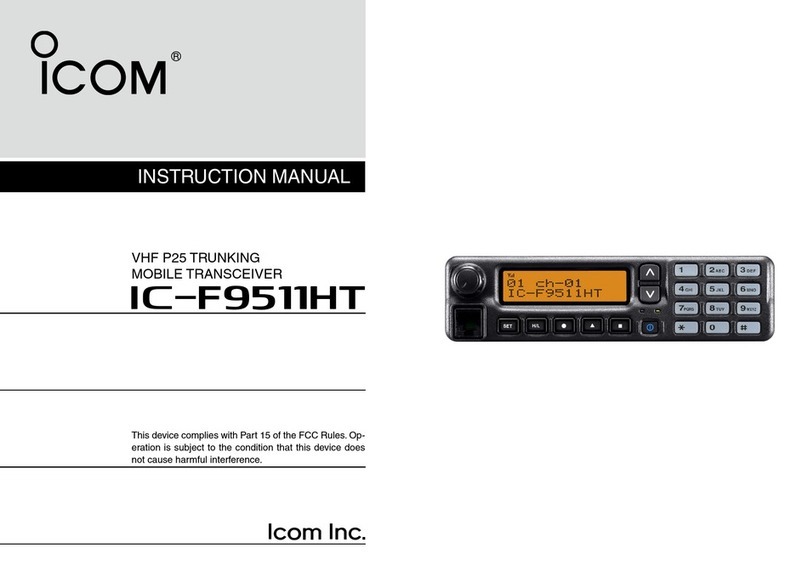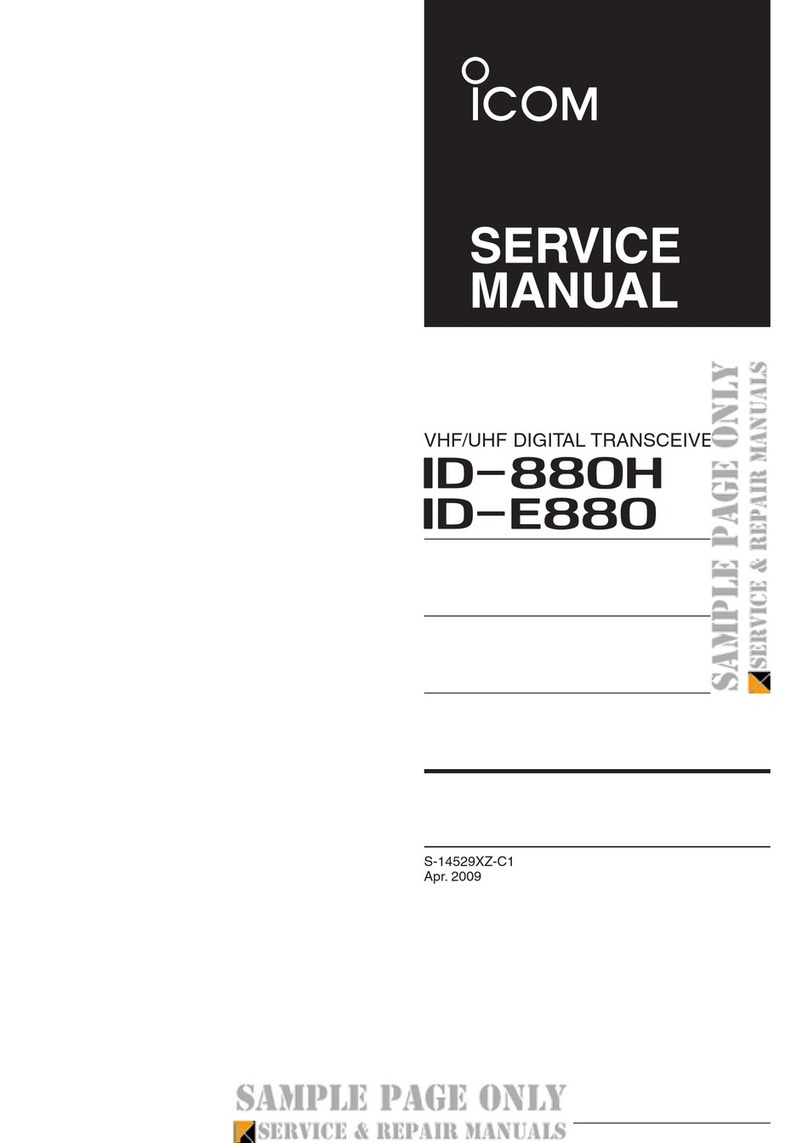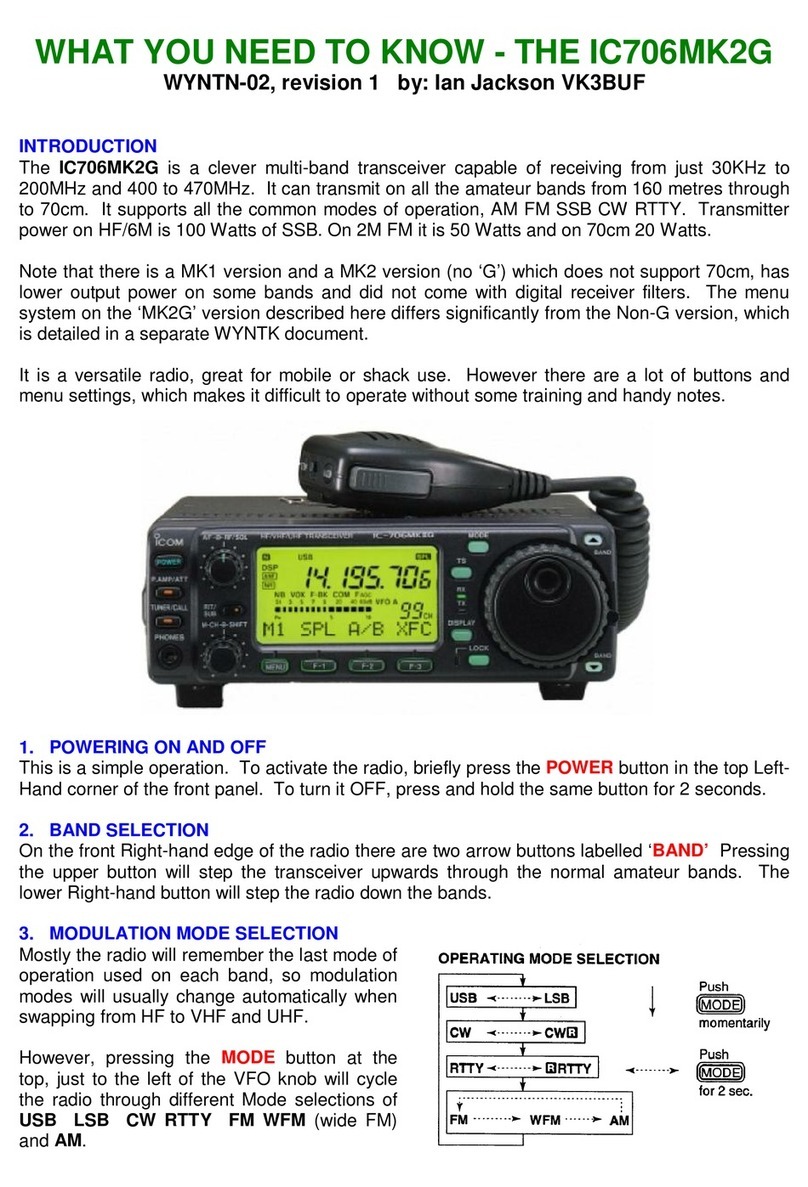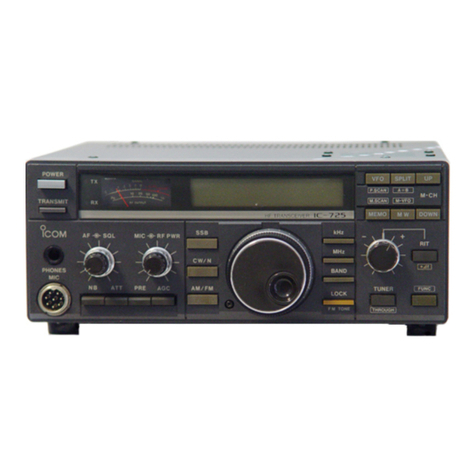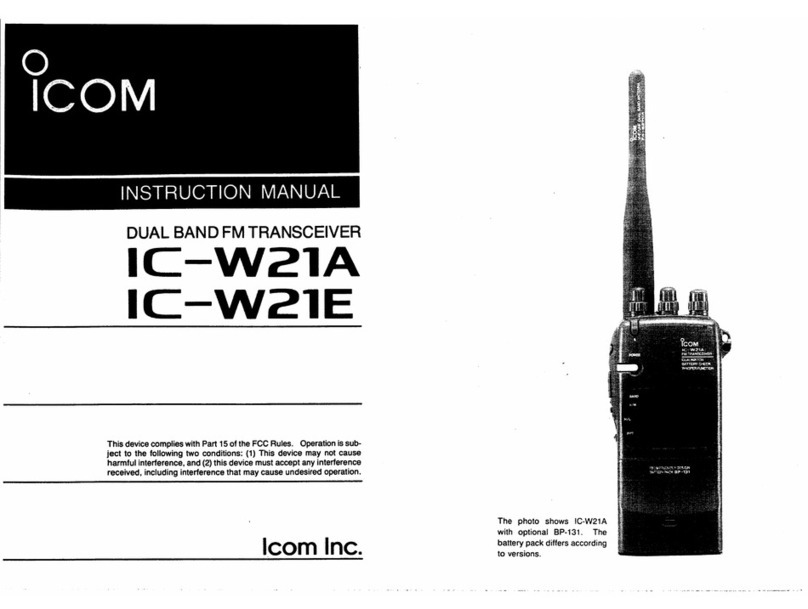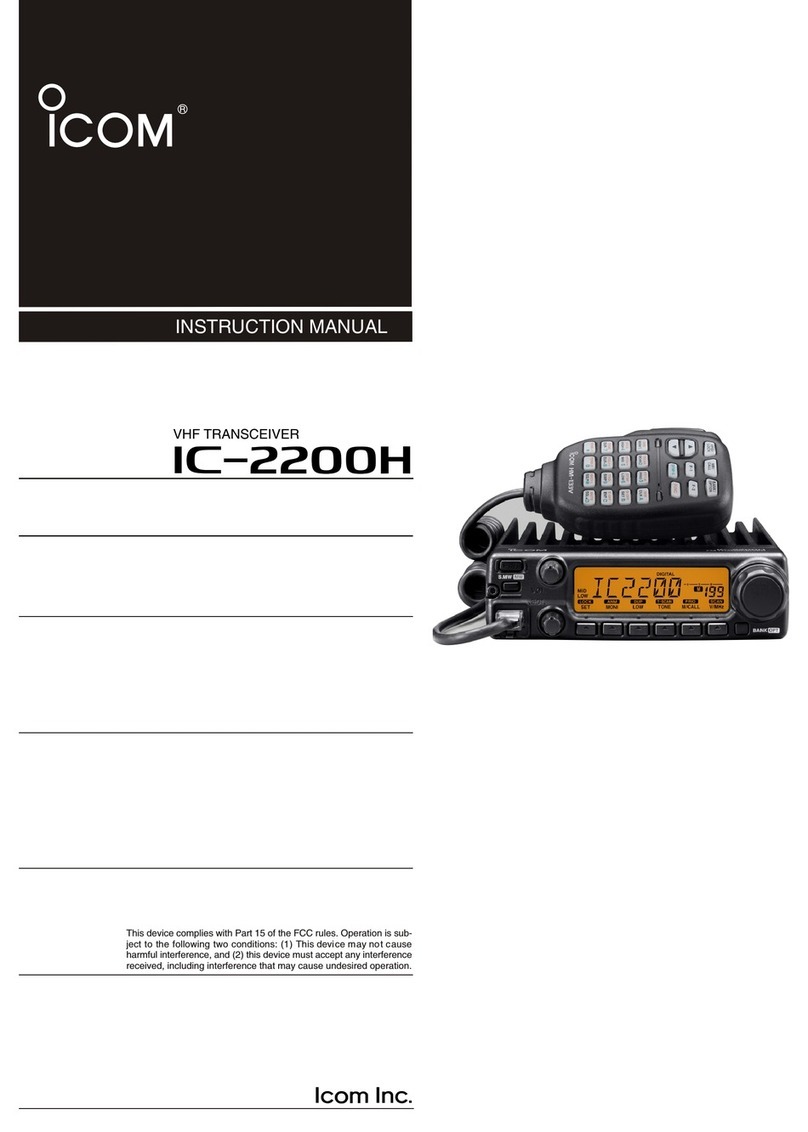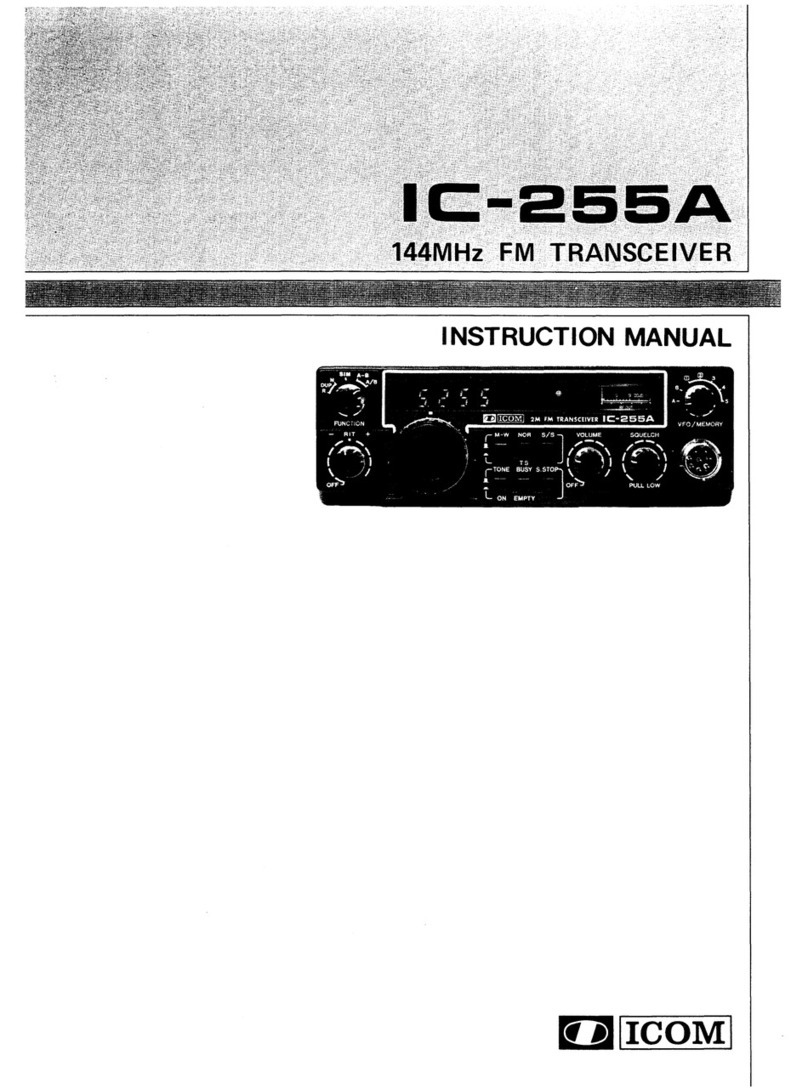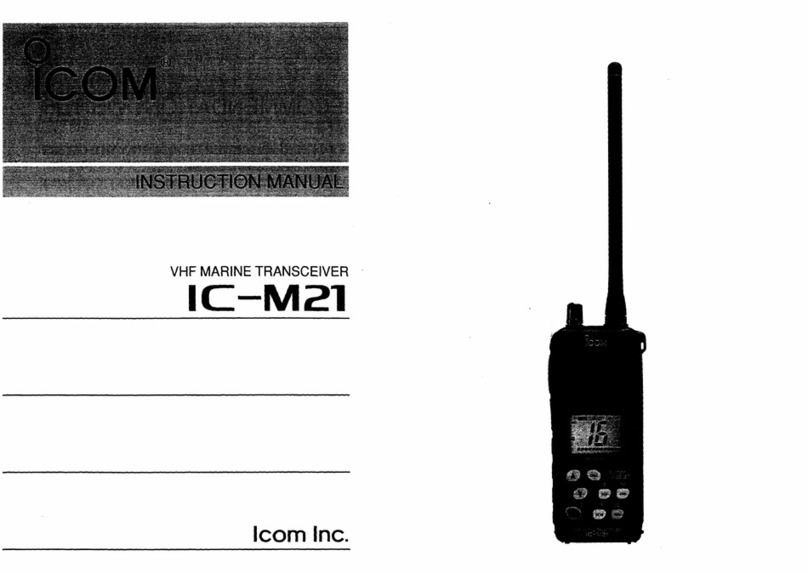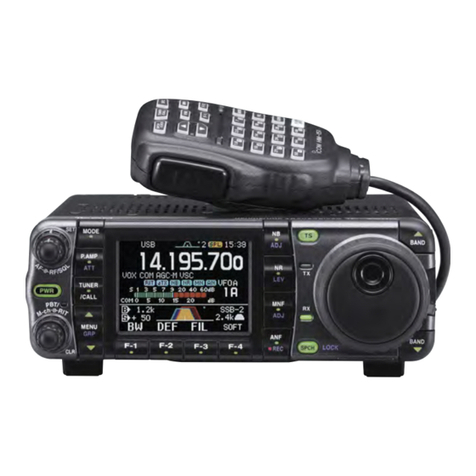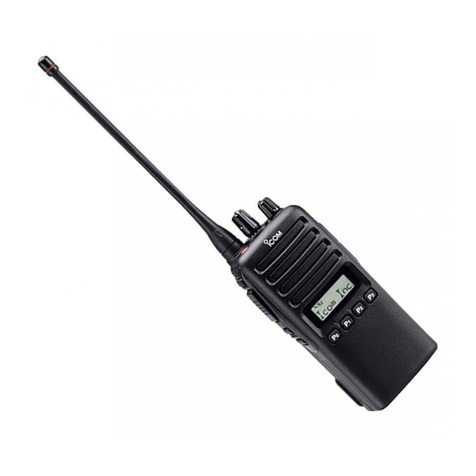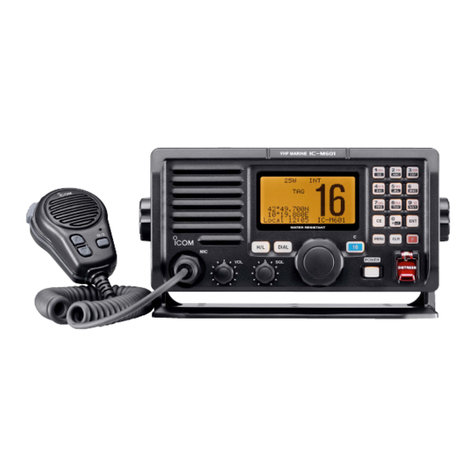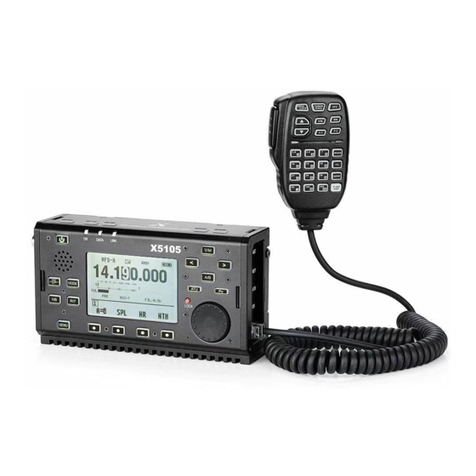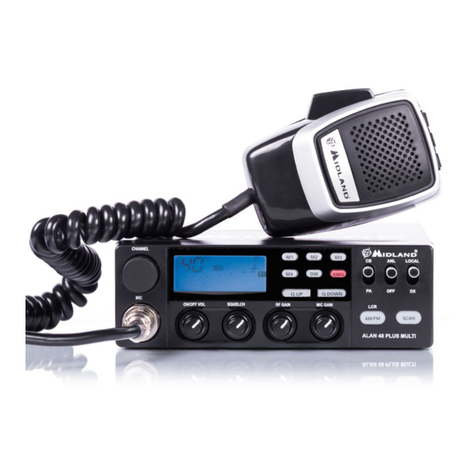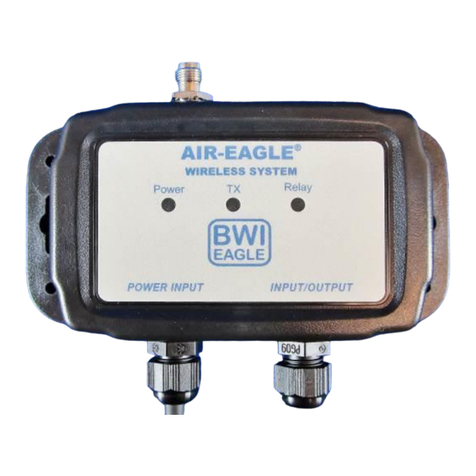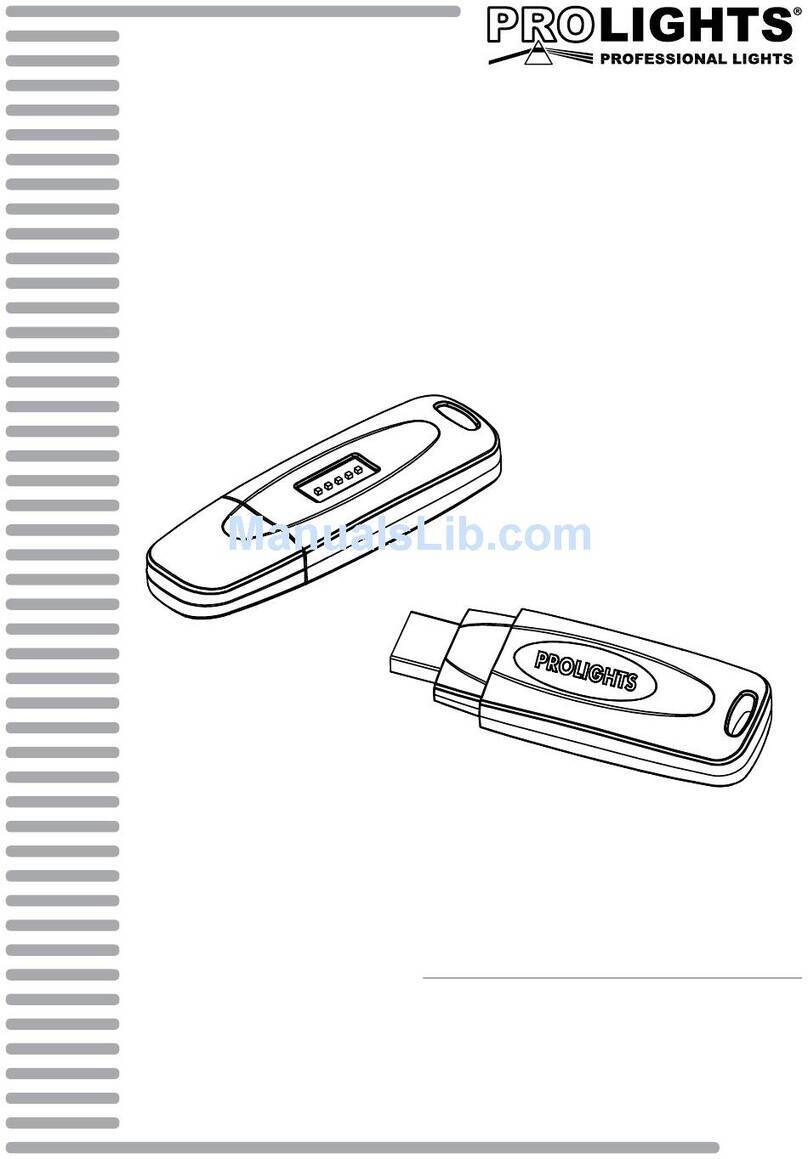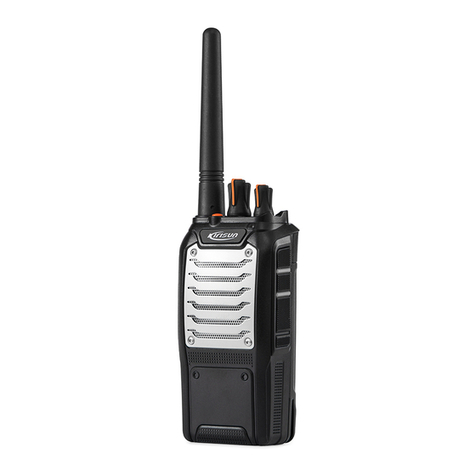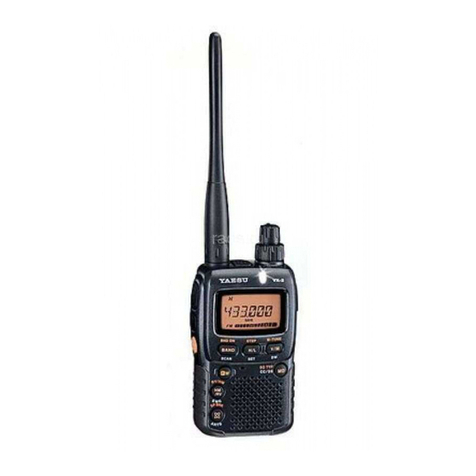Icom IC-F30GT User manual

INSTRUCTION MANUAL
This device complies with Part 15 of the FCC rules. Oper-
ation is subject to the following two conditions: (1) This de-
vice may not cause harmful interference, and (2) this
device must except any interference received, including in-
terference that may cause undesired operation.
UHF TRANSCEIVER
iF40GT/GS
iF30GT/GS
VHF TRANSCEIVER


ii
this radio by the manufacturer or an antenna specifically authorized
by the manufacturer for use with this radio.
•DO NOT transmit for more than 50% of total radio use time (
“
50%
duty cycle”). Transmitting more than 50% of the time can cause
FCC RF exposure compliance requirements to be exceeded. The
radio is transmitting when the “TX indicator” lights red. You can
cause the radio to transmit by pressing the “PTT” switch.
•ALWAYS use Icom authorized accessories (antennas, batteries,
belt clips, speaker/mics, etc). Use of unauthorized accessories can
cause the FCC RF exposure compliance requirements to be ex-
ceeded.
•ALWAYS keep the antenna at least 2.5 cm (1 inch) away from the
body when transmitting and only use the Icom belt-clips which
listed in page 25 when attaching the radio to your belt, etc., to en-
sure FCC RF exposure compliance requirements are not ex-
ceeded. To provide the recipients of your transmission the best
sound quality, hold the antenna at least 5 cm (2 inches) from
mouth, and slightly off to one side.
The information listed above provides the user with the information
needed to make him or her aware of RF exposure, and what to do
to assure that this radio operates within the FCC RF exposure lim-
its of this radio.
Electromagnetic Interference/Compatibility
During transmissions, your Icom radio generates RF energy that
can possibly cause interference with other devices or systems. To
avoid such interference, turn off the radio in areas where signs are
posted to do so. DO NOT operate the transmitter in areas that are
sensitive to electromagnetic radiation such as hospitals, aircraft,
and blasting sites.

iii
FOREWORD
Thank you for purchasing the IC-F30GT/GS, IC-F40GT/GS FM
transceiver.
READ ALL INSTRUCTIONS carefully and completely before using
the transceiver.
SAVE THIS INSTRUCTION MANUAL–This instruction manual
contains important operating instructions for the transceiver.
INSTALLATION NOTES
• When transmitting with a portable radio, hold the radio in a vertical
position with its microphone 2.5 to 5 centimeters (1 to 2 in.) away
from your mouth. Keep the antenna at least 2.5 centimeters (1 in.)
from your head and body.
• If you wear a portable two-way radio on your body, ensure that the
antenna is at least 2.5 centimeters (1 in.) from your body when
transmitting.
IMPORTANT
RCAUTION! NEVER hold the transceiver so that the antenna is
very close to, or touching exposed parts of the body, especially the
face or eyes, while transmitting. The transceiver will perform best if
the microphone is 2 to 4 in. (5 to 10 cm) away from the lips and the
transceiver is vertical.
RCAUTION! NEVER operate the transceiver with a headset or
other audio accessories at high volume levels.
RCAUTION! NEVER short the terminals of the battery pack.
DO NOT push the PTT when not actually desiring to transmit.

iv
AVOID using or placing the transceiver in direct sunlight or in areas
with temperatures below +14°F (–10°C) or above +122°F (+50°C).
The basic operations, transmission and reception of the transceiver,
are guaranteed within the specified operating temperature range
(depending on version). However, the LCD display may not be op-
erate correctly, or show an indication in the case of long hours of
operation, or after being placed in extremely cold areas.
DO NOT modify the transceiver for any reason.
KEEP the transceiver from the heavy rain, and Never immerse it in
the water. The transceiver construction is water resistant, not wa-
terproof.
The use of non-Icom battery packs/chargers may impair transceiver
performance and invalidate the warranty.
FCC caution: Changes or modifications to this transceiver, not
expressly approved by Icom Inc., could void your authority to op-
erate this transceiver under FCC regulations.

v
TABLE OF CONTENTS
SAFETY TRAINING INFORMATION . . . . . . . . . . . . . . . . . . . . . . . .i–ii
FOREWORD . . . . . . . . . . . . . . . . . . . . . . . . . . . . . . . . . . . . . . . . . . . .iii
INSTALLATION NOTES . . . . . . . . . . . . . . . . . . . . . . . . . . . . . . . . . . .iii
IMPORTANT . . . . . . . . . . . . . . . . . . . . . . . . . . . . . . . . . . . . . . . . . .iii–iv
TABLE OF CONTENTS . . . . . . . . . . . . . . . . . . . . . . . . . . . . . . . . . . . .v
1 ACCESSORIES . . . . . . . . . . . . . . . . . . . . . . . . . . . . . . . . . . . . . . . .1
2 PANEL DESCRIPTION . . . . . . . . . . . . . . . . . . . . . . . . . . . . . . . .2–4
‘Switches, controls, keys and connectors . . . . . . . . . . . . . . . . .2–3
‘Function display . . . . . . . . . . . . . . . . . . . . . . . . . . . . . . . . . . . . . .4
3 BATTERY PACKS . . . . . . . . . . . . . . . . . . . . . . . . . . . . . . . . . . .5–10
‘Battery pack replacement . . . . . . . . . . . . . . . . . . . . . . . . . . . . . .5
‘Battery cautions . . . . . . . . . . . . . . . . . . . . . . . . . . . . . . . . . . . . . .6
‘Battery charging . . . . . . . . . . . . . . . . . . . . . . . . . . . . . . . . . . .7–8
‘ Charging NOTE . . . . . . . . . . . . . . . . . . . . . . . . . . . . . . . . . . . . .9
‘ Battery case (Option) . . . . . . . . . . . . . . . . . . . . . . . . . . . . . . . .10
4 PROGRAMMABLE FUNCTIONS . . . . . . . . . . . . . . . . . . . . . .11–15
‘General . . . . . . . . . . . . . . . . . . . . . . . . . . . . . . . . . . . . . . . . . . .11
5 CONVENTIONAL OPERATION . . . . . . . . . . . . . . . . . . . . . . . .16–18
‘Receiving and transmitting . . . . . . . . . . . . . . . . . . . . . . . . . . . .16
‘Call procedure . . . . . . . . . . . . . . . . . . . . . . . . . . . . . . . . . . . . . .17
‘Tx code channel selection . . . . . . . . . . . . . . . . . . . . . . . . . . . . .18
‘Manual 5-tone codes . . . . . . . . . . . . . . . . . . . . . . . . . . . . . . . . .18
‘Transmitting notes . . . . . . . . . . . . . . . . . . . . . . . . . . . . . . . . . . .18
6 SmarTrunk IITM OPERATION . . . . . . . . . . . . . . . . . . . . . . . . . .19–21
‘Basic operation . . . . . . . . . . . . . . . . . . . . . . . . . . . . . . . . . . . . .19
7 OTHER FUNCTIONS . . . . . . . . . . . . . . . . . . . . . . . . . . . . . . . . . . .22
‘DTMF pager/Code squelch . . . . . . . . . . . . . . . . . . . . . . . . . . . .22
‘ Cloning . . . . . . . . . . . . . . . . . . . . . . . . . . . . . . . . . . . . . . . . . . .22
8 OPTIONAL UNIT INSTALLATION . . . . . . . . . . . . . . . . . . . . . . . . .23
‘ Installation . . . . . . . . . . . . . . . . . . . . . . . . . . . . . . . . . . . . . . . . .23
9 OPTIONS . . . . . . . . . . . . . . . . . . . . . . . . . . . . . . . . . . . . . . . . .24–25

1
1
ACCESSORIES
‘‘Accessory attachment
DSupplied accessories
The transceiver comes supplied with the following accessories.
qFlexible antenna
(may
differ from that shown, or
may not be supplied with
some versions)
wBelt clip
DAntenna
The antenna screws onto the transceiver
as illustrated at right.
✔
For IC-F30GT-L/GS-L
The most suitable flexible antenna
must be purchased separately, ac-
cording to the frequency coverage and
programmed frequency parameters of
each version. See page 25 for details.
DBelt clip
Attach the belt clip to the transceiver as illustrated below.
q
w
To release the belt clip
To attach the belt clip

2
PANEL DESCRIPTION
2
‘‘Switches, controls, keys and connectors
DDProgrammable key reference

8
3BATTERY PACKS
DRapid charging with the BC-121+AD-94 (#11)
The optional BC-121 allows up to 6 battery packs to be charged si-
multaneously. The following are additionally required.
• Six AD-94 (#11).
•
AnAC adapter
(may be supplied with the BC-121 depending on version)
.
DRegular charging with
the BC-137 #11/BC-146
The optional BC-137
#11
or
BC-146 provides regular
charging of optional battery
pack with/without transceiver.
The following is additionally
required:
• An optional AC adapter.
(AD-99 is supplied with BC-
137 #11/BC-146)
MULTI-CHARGER
AC adapter
(purchased
separately) Charge indicator
(each indicator functions independently)
Turn power OFF.
Check orienta-
tion for correct
charging. (In-
sert together
with AD-99.)
Turn power OFF.
BC-137 #11
or BC-146

9
3
BATTERY PACKS
‘‘Charging NOTE
Prior to using the transceiver for the first time, the battery pack must
be fully charged for optimum life and operation.
• Recommended temperature range for charging:
+10°C to +40°C (50°F to 140°F).
• Use the supplied charger or optional charger (BC-119/BC-121/BC-
144 for rapid charging, BC-137 #11/BC-146 for regular charging) only.
NEVER use other manufacturers’ chargers.
The optional BP-209 or BP-210 battery packs include rechargeable
Ni-Cd (Ni-MH: BP-210) batteries and can be charged approx. 300
times. Charge the battery pack before first operating the transceiver
or when the battery pack becomes exhausted.
If you want to charge the battery pack more than 300 times, the fol-
lowing points should be observed:
•Avoid over charging. The charging period should be less than
48 hours.
• Use the battery until it becomes almost completely exhausted
under normal conditions. We recommend battery charging after
transmitting becomes impossible.
DDBattery pack life
When the operating period becomes extremely short, even after
charging the battery pack fully, a new battery pack is needed.

10
3BATTERY PACKS
‘‘Battery case (Option)
When using an optional BP-208
BATTERY CASE
attached to the
transceiver, install 6 AA (R6) size alkaline batteries as illustrated
below.
DDCAUTION
• Use ALKALINE batteries only.
• Make sure all battery cells are the same brand, type and ca-
pacity.
• Never mix old and new batteries.
Either of the above may cause a fire hazard or damage the
transceiver if ignored.
• Never incinerate used battery cells since internal battery gas
may cause them to rupture.
• Never expose a detached battery case to water.
If the battery case gets wet, be sure to wipe it dry before use.

11
4
PROGRAMMABLE FUNCTIONS
‘‘General
In the following explanations, programmable function names are
bracketed, the specific switch used to activate the function depends
on programming.
DDKEYPAD LOCK FUNCTION
This function locks access to all programmable switches (except
the switch assigned for the lock function).
Push and hold the [Lock] switch for 1 sec. to toggle the lock function
ON and OFF.
• “ ”appears while the lock function is ON.
• This function may be inhibited on some channels.
DDPRIORITY CHANNEL
This function is used to select a pre-programmed channel at the
push of a switch.
Push the [PriorityA/A(Rewrite)/B] switch to select the priority chan-
nel.
• “Prio A” or “Prio B”appears briefly, then the priority channel is auto-
matically selected.
DDSCAN FUNCTION
The scan function allows you to search a pre-programmed group
of channels for signals.
Push the [Scan A/B] switch to start/stop scan.
• Scan pauses on a channel when receiving a signal.
• Depending on programming, a message may appear while scanning.
• “Lockout SCAN” (pre-programmed list SCAN) or “Priority SCAN” can
be pre-programmed.
• When the “Power-save function” is activated, the transceiver checks
all pre-programmed channels then returns to the “Power-save func-
tion” again.

12
4PROGRAMMABLE FUNCTIONS
DDHIGH/LOW POWER OUTPUT
This function selects high or low power for a channel.
Push the [High/Low] switch to change transmit output power be-
tween high, low1 and low2 power.
• “ ” appears when low1 or low2 output power is selected.
DDSCRAMBLER FUNCTION
(optional UT-109 (#02)* or UT-110 (#02)* is required.)
This function provides higher communication security.
UT-109: Non-rolling type. 32 code numbers are available.
UT-110: Rolling type. 1020 (4 groups ×255) code numbers are
available.
Push the [Scrambler] switch to toggle the function ON and OFF.
NOTE: NEVER use #01 Low AF level versions, as they are not
compatible

13
4
PROGRAMMABLE FUNCTIONS
DDMONITOR AUDIBLE FUNCTION
The monitor function allows you to open the transceiver’s squelch
manually to check whether a channel is busy or not. The trans-
ceiver has 2 conditions for receive standby:
Audible condition:
This condition mutes audio ONLY when
no carrier is present. You can receive (or
monitor) any signals on a channel.
• Push and hold the [Moni] (LMR) or
[Moni (Audi)] (PMR) switch to select the
audible condition.
Any audio mute functions are cancelled
while pushing the [Moni] (LMR) or
[Moni (Audi)] (PMR) switch.
Inaudible condition:
This condition mutes ALL signals except
those directed to you. Therefore you
should check a channel’s condition (busy
or not) with the monitor function before
transmitting.
• Push the [Moni] (LMR) or [Moni (Audi)]
(PMR) switch momentarily to select the in-
audible condition.
DDTALK AROUND
The talk around function changes duplex channels to simplex chan-
nels.
• Duplex allows you to contact your base station, repeaters, etc.
• Simplex allows you to contact other portable transceivers directly
(portable-to-portable contact).
Push the [Talk Around] switch to toggle the function ON and OFF.
All signals are received.
Only signals containing the
proper tone are received.

14
4PROGRAMMABLE FUNCTIONS
DDDTMF TRANSMISSION
This function allows you to send a pre-programmed DTMF code to
control a repeater, open another transceiver’s squelch, etc.
Manual transmission:
Push the desired digit keys in sequence while pushing [PTT].
• Pushing [PTT] may not be necessary depending on programming.
Automatic pre-programmed transmission:
qPush the [DTMFAutodial] switch to select DTMF autodial mode,
then push [CH Up] or [CH Down] to select the desired channel.
wPush the [DTMF Autodial] switch to send a DTMF code.
DDDTMF RE-DIAL FUNCTION
This function allows you to transmit the last-used DTMF code at the
push of a key.
Push the [Re-dial] switch momentarily to activate the function.
• The previously transmitted DTMF code is automatically transmitted.
• If no code has been transmitted since turning the power ON, this func-
tion does not activate.
DDEMERGENCY FUNCTION
The emergency function allows you to send an emergency signal
quickly and easily to your Base Station, etc. in case of emergency.
Push and hold the [Emergency Single/Repeat] switch for 1 sec. to
activate the emergency function.
• The transceiver selects a pre-programmed channel, then sends an
emergency signal to your Base Station.
• The pre-programmed channel remains selected until a control signal is
received from the Base Station, or power is turned OFF.
• The emergency call is repeatedly transmitted at pre-programmed in-
tervals.

15
4
PROGRAMMABLE FUNCTIONS
DDDISPLAY LIGHTING
The function display has 3 backlight conditions.
ON : Backlight turns ON continuously.
OFF : No backlight is available.
AUTO : When any key, except [PTT], is pushed, the backlight
turns ON for 5 sec. automatically.
DDSmarTrunk IITM functions
This transceiver provides SmarTrunk IITM functions.
(Optional UT-105
SmarTrunk IITM Logic Board
is required.)
The optional UT-105 allows communication over conventional
channels or SmarTrunk IITM channels. Select a channel bank for
SmarTrunk IITM before trunking operation.
To toggle SmarTrunk IITM channels and conventional channels, push
the [Bank] switch one or more times.
• Scanning starts when a channel bank for SmarTrunk IITM is selected.
• Contact your dealer for channel bank details.
(See p. 19 for more detailed operation.)

16
5CONVENTIONAL OPERATION
‘‘Receiving and transmitting
NOTE: Transmitting without an antenna may damage the trans-
ceiver. See p. 1 for antenna attachment.
Turn power ON as described on p. 3.
Receiving:
qPush [CH Up]/[CH Down], or rotate [SEL] to select a channel.
wListen for a transmission and adjust [VOL] to a comfortable lis-
tening level.
• When no transmission is heard, push and hold monitor while ad-
justing [VOL] (your transceiver may not be programmed with the
monitor function).
The transceiver is now set to receive desired calls on the selected
channel.
Transmitting:
Wait for the channel to become clear to avoid interference.
eWhile pushing and holding [PTT], speak into the microphone at a
normal voice level.
• When a tone signalling system is used, the call procedure de-
scribed at right may be necessary.
rRelease [PTT] to return to receive.
IMPORTANT: To maximize the readability of your transmitted sig-
nal, pause a few seconds. After pushing [PTT], hold
the microphone 2 to 4 in. (5 to 10 cm) from your
mouth and speak at a normal voice level.

17
5
CONVENTIONAL OPERATION
‘‘Call procedure
When your system employs tone signalling (excluding CTCSS and
DTCS), the call procedure may be necessary prior to voice trans-
mission. The tone signalling employed may be a selective calling
system which allows you to call specific station(s) only and prevent
unwanted stations from contacting you.
qSelect the desired Tx code channel or 5-tone code according to
your System Operator’s instructions.
• This may not be necessary depending on programming.
• Refer to the next page for selection.
wPush the call switch (assigned to one of the dealer programma-
ble switches: [P0], [P1], [P2], [P3], [F2] and [F3]).
eAfter transmitting a 5-tone code, the remainder of your commu-
nication can be carried out in the normal fashion.
Selective calling Non-selective calling

18
5CONVENTIONAL OPERATION
‘‘Tx code channel selection
Your radio may be programmed for Tx code channel selection. In
this case, you can choose a Tx code channel to be transmitted
when using the call function (p. 17).
Push [Tx Code CH Up/Down] (assigned to one of the dealer-pro-
grammable switches) to select the desired Tx code channel.
• The selected code channel (containing a pre-programmed 5-tone
code) is transmitted when using the call function.
‘‘Manual 5-tone codes
Depending on programming, you may be able to send 5-tone codes
manually.
Push [Tx Code] to activate the function, then enter the desired
transmit code (up to 7 digits) using the keypad.
• Activate the call function to transmit the 5-tone code.
• Blinking indicates keypad entry is acceptable.
‘‘Transmitting notes
DDTIME-OUT TIMER
After continuous transmission for a pre-programmed period, the
time-out timer is activated, causing the transceiver to stop trans-
mitting.
DDPENALTY TIMER
Once the time-out timer is activated, transmission is further in-
hibited for a period determined by the penalty timer.

19
6
SmarTrunk IITM OPERATION
‘‘Basic operation
These features are enabled by your Dealer or System operator and
may not be available in your system. Contact your Dealer for details.
Push the [Bank] switch one or more times to select a channel bank
for conventional channels or SmarTrunk II™ channels.
• Scanning starts when a channel bank for SmarTrunk IITM is selected.
DDPTT dispatch operation*1
qPush [PTT] once (without dialling) to initiate a dispatch call.
wBegin talking after you hear three beeps (one short, high-
pitched, two very-short, low-pitched).
eReceiving a dispatch call is indicated by the same three-beep
sequence.
• It is not necessary to push [M] to answer a dispatch call.
DDSystem busy indication
If all channels are busy, three low beeps sound after you initiate
a call. Try the call again later.
DDReceiving a subscriber-to-subscriber call*1
When you hear ringing, push [M] to answer.
• For a group call, you hear a short ring followed by two short beeps.
You do not have to answer a group call to hear it over the air.
DDReceiving a landline-to-subscriber call*1
When you hear ringing, push [M] to answer.
• For a group call, you hear a short ring followed by two short beeps.
You do not have to answer a group call to hear it over the air.
DDTerminating a call*1
After completing a call, push [#] to disconnect (hang up).
IMPORTANT: If one person in the conversation terminates a call,
all participants will be cut off.
Other manuals for IC-F30GT
3
This manual suits for next models
3
Table of contents
Other Icom Transceiver manuals
Popular Transceiver manuals by other brands
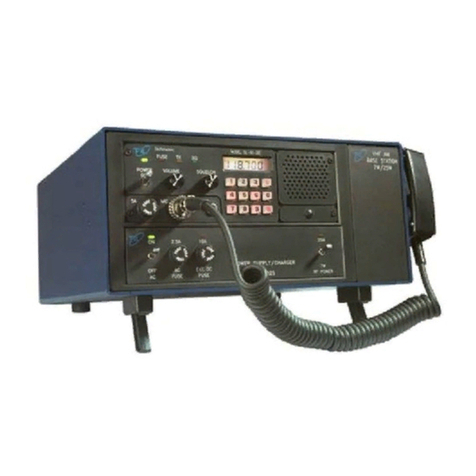
Technisonic Industries Limited
Technisonic Industries Limited TiL-91-DE/S Installation and operating instructions
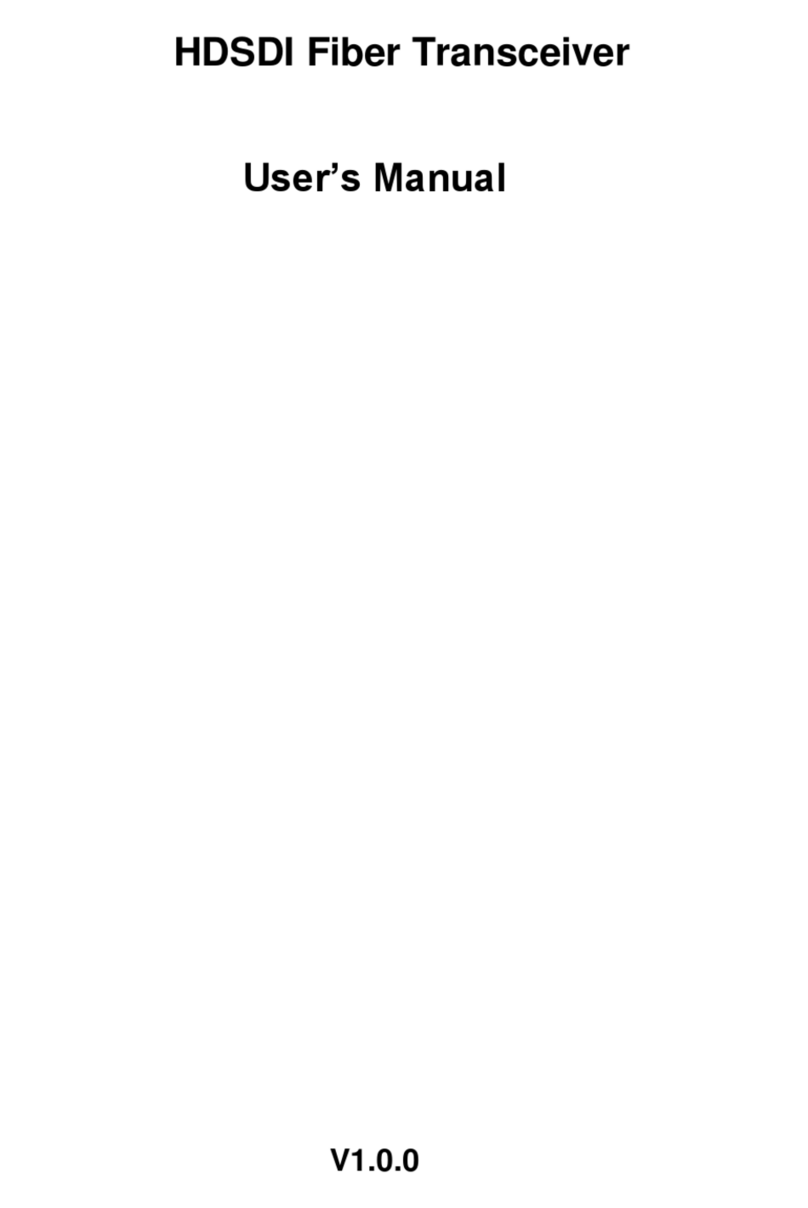
Dahua
Dahua OTS102T user manual

Hytera
Hytera PT350 Quick reference guide
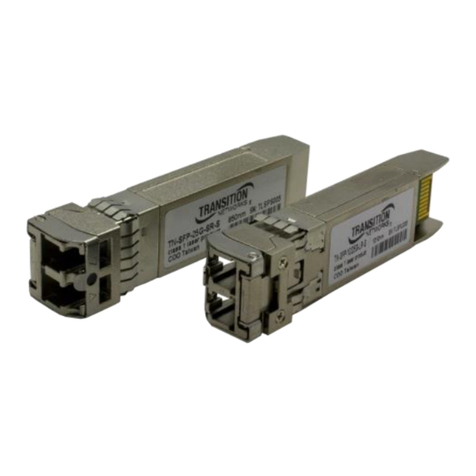
Transition
Transition TN-SFP Series user guide

Kenwood
Kenwood TH-79A instruction manual
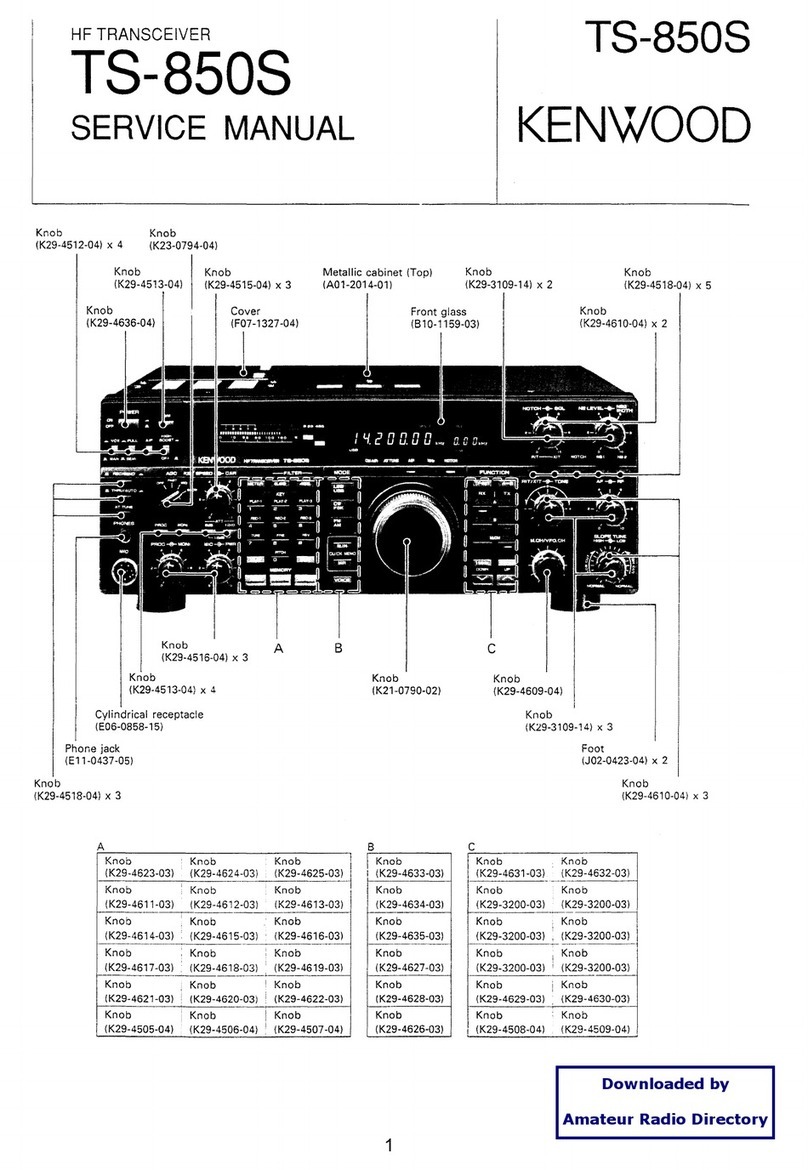
Kenwood
Kenwood TS-850S Service manual
